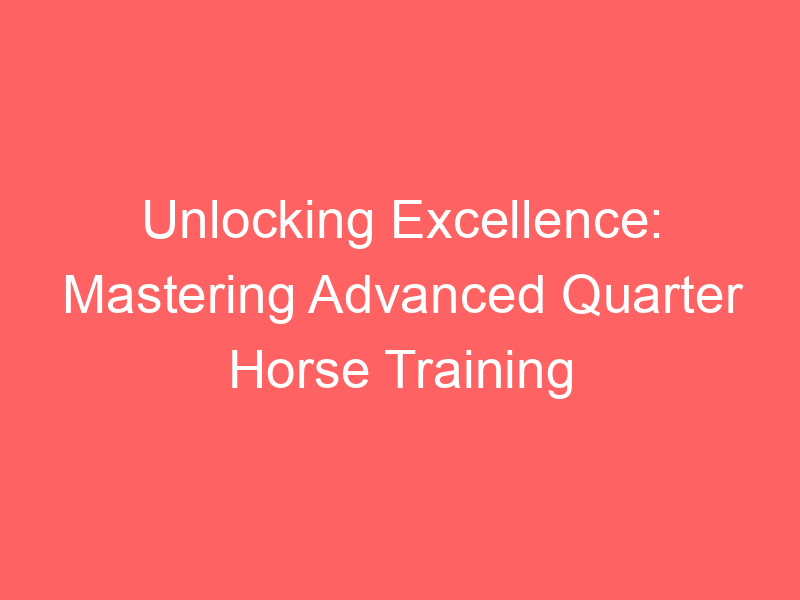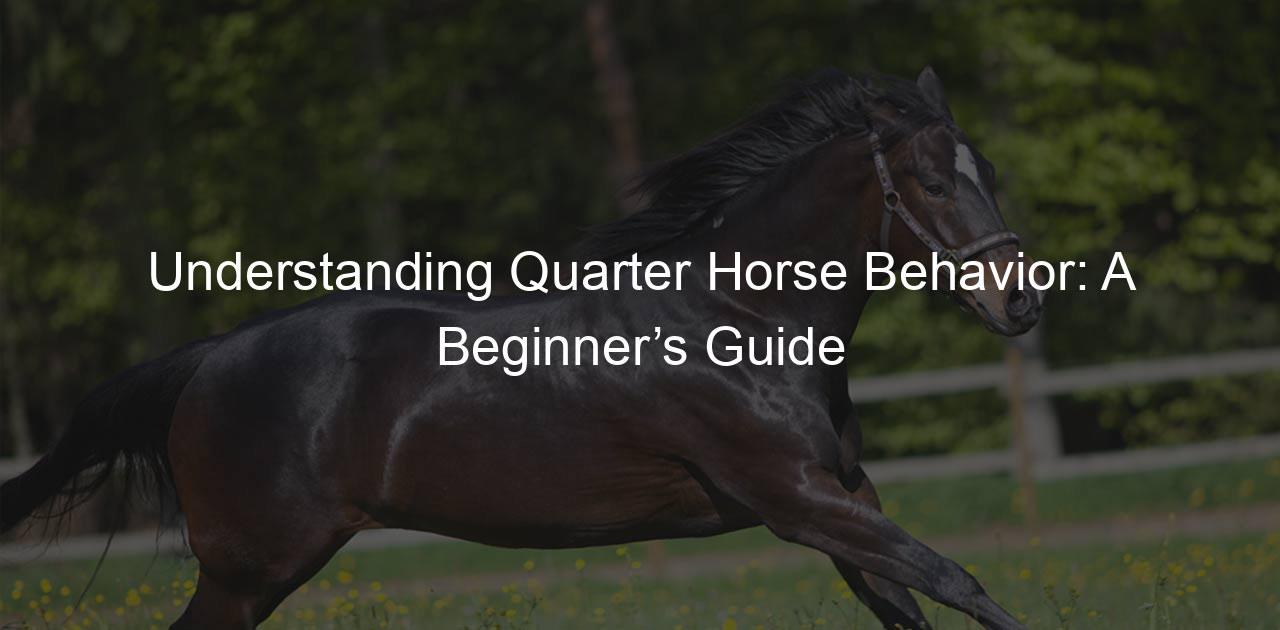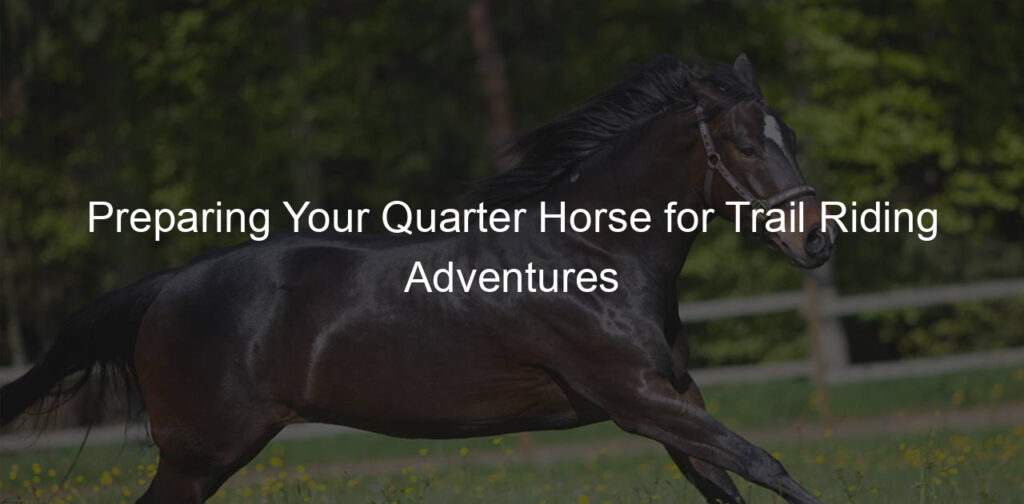
Introduction to Advanced Quarter Horse Training
Welcome to the exciting world of advanced quarter horse training. This comprehensive guide is designed to provide you with a deeper understanding of the importance of advanced training and how it can help maximize your horse’s potential.
- Understanding the Importance of Advanced Horse Training
- Maximizing Horse Potential through Professional Quarter Horse Training
Advanced horse training is a critical aspect of raising a quarter horse. It goes beyond basic obedience and focuses on enhancing the horse’s skills, agility, and performance. This level of training is essential for horses that participate in competitive events or those that work in demanding environments.
Advanced training not only improves a horse’s physical abilities but also strengthens their mental capacity. It helps horses to understand complex commands, adapt to different situations, and respond effectively to their handler’s cues. This level of understanding and responsiveness is crucial for a horse’s safety and success.
Professional quarter horse training is an investment in your horse’s future. It’s about unlocking their full potential and helping them reach their peak performance. A professionally trained quarter horse is more responsive, agile, and capable of handling challenging tasks.
Professional training involves a structured and systematic approach. It includes a combination of exercises, drills, and techniques that are designed to improve a horse’s strength, stamina, agility, and responsiveness. These training methods are based on proven scientific principles and are tailored to meet the specific needs of each horse.
By investing in professional quarter horse training, you’re not just improving your horse’s skills and abilities. You’re also enhancing their overall well-being and quality of life. A well-trained horse is a happy and healthy horse.
Essential Quarter Horse Training Techniques
Training a quarter horse is a rewarding task that requires patience, consistency, and knowledge of effective techniques. In this section, we will explore some of the basic training techniques that are essential for every quarter horse owner and trainer.
Basic Training Techniques
Before we delve into the more advanced techniques, let’s start with the basics. These are the foundational skills that every quarter horse should master.
- Establishing Trust and Respect
- Teaching Basic Commands
Trust and respect are the cornerstones of any successful horse training program. Without these, it’s unlikely that your horse will respond positively to your commands. Start by spending quality time with your horse. Feed them, groom them, and speak to them in a calm and soothing voice. This will help to build a strong bond between you and your horse, making the training process much easier.
Once you’ve established trust and respect, it’s time to start teaching your horse some basic commands. Start with simple commands like “stop”, “go”, “turn”, and “back up”. Remember, consistency is key. Use the same words, tone, and body language each time you give a command. This will help your horse to understand and respond to your commands more quickly.
Mastering these basic training techniques is the first step towards becoming a successful quarter horse trainer. Remember, patience and consistency are key. Don’t rush the process. Give your horse the time they need to learn and understand each new command.
Advanced Horse Training Techniques
Once the basics of horse training are mastered, it’s time to move on to more advanced techniques. These techniques are designed to help your quarter horse reach its full potential, improving both its skills and performance.
- Developing Advanced Skills
- Improving Quarter Horse Performance
Advanced horse training techniques are all about refining the skills your horse already has. This includes perfecting their gait, improving their responsiveness to commands, and teaching them more complex maneuvers. For example, a well-trained quarter horse should be able to perform a sliding stop, a move where the horse comes to a complete stop from a gallop, sliding on its hindquarters. This requires a high level of skill and trust between the horse and rider.
Developing these advanced skills requires patience and consistency. It’s important to practice regularly and to always end training sessions on a positive note. Remember, the goal is to build on the foundation you’ve already established, not to push your horse too hard too fast.
Improving your quarter horse’s performance involves more than just training. It also includes proper care and nutrition. A well-fed and well-cared-for horse will have the energy and stamina needed to perform at its best.
One way to improve performance is through conditioning exercises. These exercises, such as hill work or interval training, can help increase your horse’s strength and endurance. It’s also important to remember that rest is just as important as exercise. Horses need time to recover and rebuild their muscles after a hard workout.
| Advanced Training Technique | Benefit |
|---|---|
| Perfecting gait | Improves horse’s movement and agility |
| Responsiveness to commands | Enhances communication between horse and rider |
| Complex maneuvers | Increases horse’s skill level |
| Conditioning exercises | Boosts horse’s strength and endurance |
In conclusion, advanced horse training techniques can greatly improve your quarter horse’s skills and performance. However, it’s important to remember that these techniques should be introduced gradually and always with the horse’s wellbeing in mind.
Maximizing Horse Potential
When it comes to maximizing the potential of your quarter horse, it’s crucial to focus on both physical and mental conditioning. Let’s dive into the details of physical conditioning first.
Physical Conditioning
Physical conditioning is a key aspect of quarter horse training. It involves regular exercise and a balanced diet to ensure optimal performance. Let’s explore these two elements in detail.
- Exercise routines for quarter horses
- Nutrition for optimal performance
Exercise is vital for a quarter horse’s health and performance. A well-rounded exercise routine should include warm-up exercises, strength training, and cool-down activities. For instance, a typical routine might start with 15 minutes of walking, followed by 30 minutes of trotting, and ending with 15 minutes of cooling down. Remember, the exercise routine should be tailored to the horse’s age, health, and performance goals.
Nutrition plays a significant role in a quarter horse’s performance. A well-balanced diet should include hay, grains, fruits, and vegetables, along with plenty of fresh water. For instance, a 1,000-pound horse typically requires 15-20 pounds of hay and 5-7 pounds of grain per day. However, the exact amount may vary depending on the horse’s age, size, and activity level. Always consult with a veterinarian or equine nutritionist to ensure your horse is getting the right nutrients.
By focusing on physical conditioning, you can help your quarter horse reach its full potential. In the next section, we will discuss mental conditioning, another crucial aspect of horse training.
Mental Conditioning
Just as we humans need to be mentally fit to perform our daily tasks, horses too need mental conditioning to reach their full potential. Let’s delve into two key aspects of mental conditioning: building confidence in your horse and teaching advanced commands.
- Building Confidence in Your Horse
- Teaching Advanced Commands
Building confidence in your horse is a crucial step in advanced quarter horse training. Confidence is the foundation of a horse’s ability to learn and perform. A confident horse is more likely to trust its trainer, respond positively to commands, and handle new situations with ease.
One effective way to build confidence in your horse is through consistent and positive reinforcement. Reward your horse for good behavior and correct responses. This can be as simple as a pat on the neck or a treat. Over time, your horse will associate positive experiences with training, boosting its confidence.
Another method is to gradually expose your horse to new experiences. Start with simple tasks and gradually increase the complexity. This step-by-step approach helps your horse build confidence and reduces the likelihood of fear or anxiety.
Teaching advanced commands is another important aspect of mental conditioning. Advanced commands are more complex than basic ones and require a higher level of understanding and trust between the horse and the trainer.
Start by ensuring your horse has mastered basic commands. Once your horse is comfortable with the basics, you can begin introducing advanced commands. Remember, patience is key. It may take time for your horse to understand and respond to these commands correctly.
Use clear, consistent cues when giving commands. Horses are sensitive to both verbal and non-verbal cues, so consistency is crucial. Also, remember to reward your horse for correctly following commands. This not only reinforces the behavior but also strengthens the bond between you and your horse.
In conclusion, mental conditioning is a vital part of maximizing your horse’s potential. By building confidence and teaching advanced commands, you can help your horse reach new heights in performance and skill.
Professional Quarter Horse Training
When it comes to maximizing the potential of your quarter horse, professional training is a crucial step. This section will guide you on how to choose a professional trainer and the benefits of professional training.
Choosing a Professional Trainer
Choosing the right professional trainer for your quarter horse is a critical decision. Here are some key factors to consider:
- What to look for in a trainer
- Benefits of professional training
Experience and expertise are paramount. Look for a trainer with a proven track record in quarter horse training. They should have a deep understanding of the horse’s behavior, needs, and capabilities. A good trainer will also be patient, communicative, and passionate about their work. They should be able to provide references from previous clients and demonstrate a clear training plan.
Professional training can significantly enhance your horse’s performance. It provides structured learning, which can help your horse develop the necessary skills faster. A professional trainer can identify your horse’s strengths and weaknesses and tailor the training accordingly. They can also ensure that your horse is trained in a safe and supportive environment. According to a study, horses trained by professionals showed a 30% improvement in their performance compared to those trained by amateurs.
In conclusion, choosing a professional trainer for your quarter horse is an investment that can yield significant returns. It can help your horse reach its full potential and excel in its performance.
Working with a Professional Trainer
When it comes to professional quarter horse training, the relationship between you and your trainer is crucial. It’s not just about the skills and techniques they teach, but also how effectively you can communicate and maximize the benefits of their expertise. Here are some tips to help you get the most out of your professional training experience.
- How to Communicate Effectively with Your Trainer
- Be clear about your goals: Before you start training, discuss your goals and expectations with your trainer. This will help them tailor the training program to meet your specific needs.
- Ask questions: Don’t hesitate to ask questions if you don’t understand something. Your trainer is there to help you learn and improve.
- Provide feedback: Regularly share your thoughts and feelings about the training process. This will help your trainer adjust the program as needed.
- Maximizing the Benefits of Professional Training
- Stay committed: Consistency is key in training. Make sure to attend all sessions and practice regularly at home.
- Apply what you learn: Try to apply the skills and techniques you learn during training in real-life situations. This will help reinforce your learning.
- Keep an open mind: Be open to trying new techniques and strategies. You might discover something that works really well for you and your horse.
Clear and open communication is key to a successful training relationship. Here are some ways to ensure effective communication with your trainer:
Professional training can provide numerous benefits, but it’s up to you to make the most of these opportunities. Here are some tips to maximize the benefits of your training:
In conclusion, working with a professional trainer can significantly enhance your quarter horse training experience. By communicating effectively and maximizing the benefits of training, you can ensure that both you and your horse reach your full potential.
Advanced Equestrian Techniques
As you progress in your journey as an equestrian, you’ll find that there are more advanced techniques to learn and master. These techniques can help you become a better rider and improve your relationship with your horse. Let’s delve into some of these advanced riding techniques and ways to improve your equestrian skills.
- Understanding Advanced Riding Techniques
Advanced riding techniques go beyond the basics of riding. They involve a deeper understanding of horse behavior, as well as refined control and communication with the horse. Here are some advanced techniques you might want to explore:
| Technique | Description |
|---|---|
| Leg Yielding | This is a lateral movement where the horse moves forward and sideways at the same time. It helps improve the horse’s flexibility and obedience. |
| Half Pass | In a half pass, the horse moves diagonally, with its head pointing in the direction of movement. This technique requires a high level of balance and coordination. |
| Flying Change | This is a technique where the horse changes its leading leg in canter during a jump. It’s a challenging but essential skill in advanced dressage and show jumping. |
- Improving Your Own Equestrian Skills
Improving your equestrian skills requires practice, patience, and a willingness to learn. Here are some tips to help you improve:
- Take Regular Lessons: Regular lessons with a qualified instructor can help you refine your skills and correct any bad habits.
- Practice Regularly: The more you ride, the better you’ll get. Try to ride several times a week, if possible.
- Stay Fit: Riding is a physically demanding activity. Staying fit can help you ride better and prevent injuries.
- Learn From Others: Watch other experienced riders and learn from them. They can provide valuable insights and techniques that you can incorporate into your own riding.
Remember, becoming an advanced equestrian is a journey. It takes time, effort, and a lot of practice. But with dedication and the right approach, you can master these advanced techniques and become a skilled equestrian.
Quarter Horse Skills Improvement
Improving your quarter horse’s skills is a continuous process that requires dedication, patience, and the right techniques. In this section, we will focus on the importance of continuous training and how it can help enhance your horse’s abilities.
Continuous Training
Continuous training is a key aspect of quarter horse skills improvement. It involves a consistent and ongoing effort to maintain and enhance the skills of your horse. Let’s delve into the two main components of continuous training:
- Maintaining skills through regular practice
- Advanced training exercises for continuous improvement
Regular practice is the cornerstone of any training program. It helps your horse retain the skills it has already learned and become more proficient in them. For instance, if your horse has learned to trot, regular practice will help it trot with more ease and grace. This is similar to how we humans get better at a task by doing it repeatedly.
Once your horse has mastered the basic skills, it’s time to introduce advanced training exercises. These exercises are designed to challenge your horse and push its limits, leading to continuous improvement. For example, you could introduce jumping exercises or complex maneuvers. Remember, the goal is not to overwhelm your horse but to gradually increase its skill level.
In conclusion, continuous training is a vital part of quarter horse skills improvement. It involves regular practice to maintain skills and advanced exercises for continuous improvement. By dedicating time and effort to continuous training, you can help your horse reach its full potential.
Overcoming Training Challenges
Training a quarter horse can be a rewarding experience, but it’s not without its challenges. Let’s delve into some of the common obstacles trainers face and explore strategies to overcome them.
- Common challenges in quarter horse training
One of the most common challenges in quarter horse training is the horse’s fear or resistance to new experiences. This can manifest as refusal to perform certain tasks, or even aggressive behavior. Another challenge is maintaining the horse’s interest and focus during training sessions. Horses, like humans, can become bored or distracted, which can hinder their learning progress.
Health and physical issues can also pose significant challenges. Horses may suffer from a variety of ailments, from minor injuries to chronic conditions, which can impact their ability to train effectively. Additionally, understanding and communicating with a horse is a unique challenge in itself. Unlike humans, horses communicate primarily through body language, so trainers must learn to interpret these signals accurately.
- Strategies for overcoming these challenges
Overcoming these challenges requires patience, understanding, and a well-planned strategy. For fear or resistance issues, gradual exposure to new experiences can help. Start with small, manageable tasks and gradually increase the difficulty as the horse becomes more comfortable.
To maintain interest and focus, vary the training routine and incorporate play and rewards. This not only keeps the sessions engaging but also reinforces positive behavior.
For health and physical issues, regular check-ups with a veterinarian are crucial. A healthy horse is a trainable horse, so ensure your horse is in optimal health before embarking on any training program.
Finally, to overcome communication challenges, spend time observing your horse. Learn to understand its unique signals and responses. Remember, every horse is different, so what works for one may not work for another.
In conclusion, while training a quarter horse can be challenging, these obstacles can be overcome with the right strategies. With patience, understanding, and a well-planned approach, you can help your horse reach its full potential.
Conclusion: Mastering Quarter Horse Training
As we reach the end of our journey into the world of advanced quarter horse training, it’s time to reflect on the key insights we’ve gained. The path to mastery is paved with knowledge, practice, and dedication. Let’s summarize the key takeaways and share some final thoughts on this fascinating subject.
- Recap of key takeaways
- Final thoughts on advanced quarter horse training
Firstly, we learned that understanding the unique characteristics of the Quarter Horse breed is crucial. Their agility, speed, and versatility make them excellent athletes, but they also require specific training techniques.
Secondly, we delved into the essential training techniques, from basic obedience to advanced equestrian skills. We learned about the importance of consistency, patience, and positive reinforcement in training.
Thirdly, we explored how to maximize a horse’s potential. This involves a holistic approach that includes proper nutrition, regular exercise, and mental stimulation.
Lastly, we discussed professional training and the benefits it can bring. A professional trainer can provide expert guidance and help avoid common pitfalls, making the training process smoother and more effective.
Mastering quarter horse training is a journey, not a destination. It requires continuous learning, practice, and dedication. But the rewards are immense. A well-trained Quarter Horse is not just an excellent athlete, but also a loyal companion and a source of immense pride.
Remember, every horse is unique and will respond differently to training. It’s important to be patient, adaptable, and understanding. And most importantly, enjoy the journey. The bond you build with your horse during training is something truly special.
As the famous horse trainer Monty Roberts once said, “Horses are a mirror of who we are. They are our opportunity to be our best selves.” So, let’s strive to be our best selves in our journey of mastering quarter horse training.









